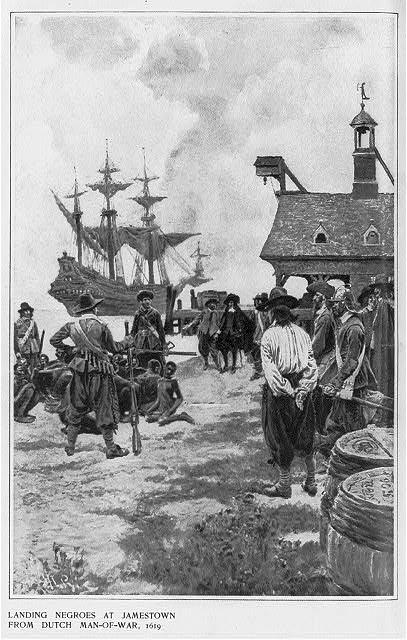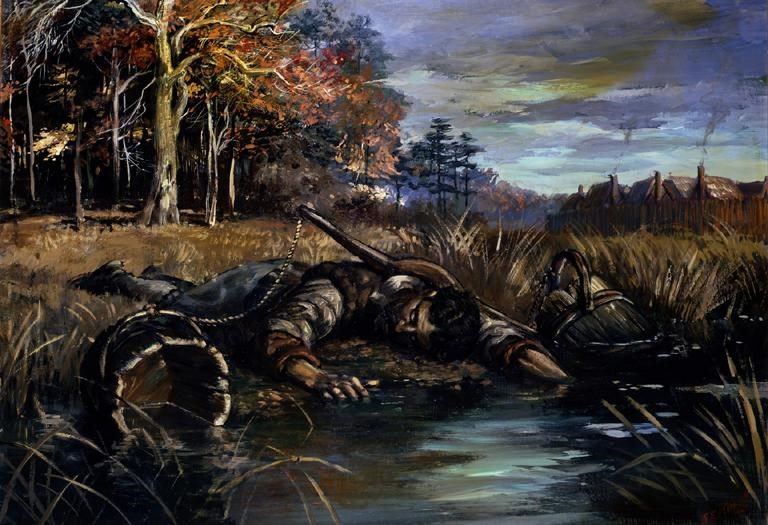|
The White Lion
The ''White Lion'' was an English privateer operating under a Dutch letter of marque which brought the first Africans to the English colony of Virginia in 1619, a year before the arrival of the ''Mayflower'' in New England. Though the African captives were sold as indentured servants, the event is regarded as the start of African slavery in the colonial history of the United States. Many Native-American tribes practiced some form of slavery before the European introduction of African slavery into North America. Native Americans did not buy and sell captives in the pre-colonial era, although they sometimes exchanged enslaved individuals with other tribes in exchange for redeeming their own members. In some cases, Native American slaves were allowed to live on the fringes of Native American society until they were slowly integrated into the tribe. The word "slave" may not accurately apply to such captive people. The first enslaved Africans in the current boundaries of the Unite ... [...More Info...] [...Related Items...] OR: [Wikipedia] [Google] [Baidu] |
Daniel Elfrith
Daniel Elfrith (fl. 1607–1641) was a 17th-century English privateer, colonist and slave trader. In the service of the Earl of Warwick, Elfrith was involved in privateering expeditions against the Spanish from his base in Bermuda. He was particularly known for capturing Spanish slave ships bound for the Spanish Main and selling the slaves himself to rival colonies in the Caribbean and the American colonies. He and John Jope were the first men to arrive in the English Colony of Virginia to sell slaves. Arriving only four days ahead his partner, Jope had sold the first African slaves in the American colonies in exchange for provisions, however Elfrith's arrival sparked considerably more controversy and was turned away by the colony. He is also one of the earliest Englishmen, along with Sussex Camock, to discover and later take part in the initial settlement of the Providence Island colony in 1629. A personal friend of the Earl of Warwick, his son-in-law Philip Bell became ... [...More Info...] [...Related Items...] OR: [Wikipedia] [Google] [Baidu] |
Slave Ships
Slave ships were large cargo ships specially built or converted from the 17th to the 19th century for transporting slaves. Such ships were also known as "Guineamen" because the trade involved human trafficking to and from the Guinea coast in West Africa. Atlantic slave trade In the early 1600s, more than a century after the arrival of Europeans to the Americas, demand for unpaid labor to work plantations made slave-trading a profitable business. The Atlantic slave trade peaked in the last two decades of the 18th century, during and following the Kongo Civil War. To ensure profitability, the owners of the ships divided their hulls into holds with little headroom, so they could transport as many slaves as possible. Unhygienic conditions, dehydration, dysentery and scurvy led to a high mortality rate, on average 15% and up to a third of captives. Often the ships carried hundreds of slaves, who were chained tightly to plank beds. For example, the slave ship ''Henrietta Mari ... [...More Info...] [...Related Items...] OR: [Wikipedia] [Google] [Baidu] |
Sailing Ships
A sailing ship is a sea-going vessel that uses sails mounted on masts to harness the power of wind and propel the vessel. There is a variety of sail plans that propel sailing ships, employing square-rigged or fore-and-aft sails. Some ships carry square sails on each mast—the brig and full-rigged ship, said to be "ship-rigged" when there are three or more masts. Others carry only fore-and-aft sails on each mast, for instance some schooners. Still others employ a combination of square and fore-and-aft sails, including the barque, barquentine, and brigantine. Early sailing ships were used for river and coastal waters in Ancient Egypt and the Mediterranean. The Austronesian peoples developed maritime technologies that included the fore-and-aft crab-claw sail and with catamaran and outrigger hull configurations, which enabled the Austronesian expansion into the islands of the Indo-Pacific. This expansion originated in Taiwan BC and propagated through Island Southeast Asi ... [...More Info...] [...Related Items...] OR: [Wikipedia] [Google] [Baidu] |
Gypsies
The Romani (also spelled Romany or Rromani , ), colloquially known as the Roma, are an Indo-Aryan ethnic group, traditionally nomadic itinerants. They live in Europe and Anatolia, and have diaspora populations located worldwide, with significant concentrations in the Americas. In the English language, the Romani people are widely known by the exonym Gypsies (or Gipsies), which is considered pejorative by many Romani people due to its connotations of illegality and irregularity as well as its historical use as a racial slur. For versions (some of which are cognates) of the word in many other languages (e.g., , , it, zingaro, , and ) this perception is either very small or non-existent. At the first World Romani Congress in 1971, its attendees unanimously voted to reject the use of all exonyms for the Romani people, including ''Gypsy'', due to their aforementioned negative and stereotypical connotations. Linguistic and genetic evidence suggests that the Roma originated ... [...More Info...] [...Related Items...] OR: [Wikipedia] [Google] [Baidu] |
Clotilda (slave Ship)
The schooner ''Clotilda'' (often misspelled ''Clotilde'') was the last known U.S. slave ship to bring captives from Africa to the United States, arriving at Mobile Bay, in autumn 1859 or July 9, 1860, with 110 African men, women, and children. The ship was a two-masted schooner, long with a beam of . U.S. involvement in the Atlantic slave trade had been banned by Congress through the Act Prohibiting Importation of Slaves enacted on March 2, 1807 (effective January 1, 1808), but the practice continued illegally, especially through slave traders based in New York in the 1850s and early 1860. In the case of the ''Clotilda'', the voyage's sponsors were based in the South and planned to buy Africans in Whydah, Dahomey.David Pilgrim.Question of the Month: Cudjo Lewis: Last African Slave in the U.S.? Jim Crow Museum, Ferris University, July 2005."Black Travel - Soul Of America , Home" (historic sites), Soul of America, 2007, webpageSoulofAmerica-6678 After the voyage, the ship was ... [...More Info...] [...Related Items...] OR: [Wikipedia] [Google] [Baidu] |
William Tucker (Virginia Colony)
William Tucker (born 1624) was born to two of the first Africans in Virginia who landed in Jamestown Colony before his birth. He was the first African American that was born in the British colonies that later became the United States. Birth William Tucker was born near Jamestown of the Colony of Virginia , and appears on the ''Virginia Muster of 1624/5'', the first comprehensive census made in North America. His parents were Isabell and Anthony, African indentured servants. When he was born, there were 22 Africans in the colony, most of whom arrived in 1619. His parents were servants to Mary and Captain William Tucker, who was an envoy to the Pamunkey Native Americans for the colony. The Tucker plantation was located at or near the current site of Bluebird Gap Farm in Hampton. Isabell and Anthony were wed in 1623 or before, with Captain Tucker's support. Under English law, indentured servants were not married while they still had time on their contract. About the time William was ... [...More Info...] [...Related Items...] OR: [Wikipedia] [Google] [Baidu] |
Edwin Sandys (died 1629)
Sir Edwin Sandys ( ; 9 December 1561 – October 1629) was an English politician who sat in the House of Commons at various times between 1589 and 1626. He was also one of the founders of the proprietary Virginia Company of London, which in 1606 established the first permanent English settlement in what is now the United States in the colony of Virginia, based at Jamestown. The parish of Sandys, in Bermuda (the Virginia Company's second colony) is named after him. Early life and career Sandys (pronounced ''Sands'') was born in Worcestershire, the second son of Edwin Sandys, Archbishop of York, and his wife Cecily Wilford. He received his education at Merchant Taylors' School, which he entered in 1571, and at Corpus Christi College, Oxford, (from 1577). He graduated B.A. in 1579 and was admitted fellow in the same year and B.C.L. in 1589. At Oxford his tutor was Richard Hooker, author of the ''Ecclesiastical Polity'', whose lifelong friend and executor Sandys became. Sandys ... [...More Info...] [...Related Items...] OR: [Wikipedia] [Google] [Baidu] |
Virginia Company Of London
The London Company, officially known as the Virginia Company of London, was a division of the Virginia Company with responsibility for colonizing the east coast of North America between latitudes 34° and 41° N. History Origins The territory granted to the London Company included the eastern coast of North America from the 34th parallel ( Cape Fear) north to the 41st parallel (in Long Island Sound). As part of the Virginia Company and Colony, the London Company owned a large portion of Atlantic and inland Canada. The company was permitted by its charter to establish a settlement within this area. The portion of the company's territory north of the 38th parallel was shared with the Plymouth Company, with the stipulation that neither company found a colony within 100 miles (161 km) of the other. The London Company made landfall on 26 April 1607, at the southern edge of the mouth of the Chesapeake Bay, which they named Cape Henry, near present-day Virginia Beach. Dec ... [...More Info...] [...Related Items...] OR: [Wikipedia] [Google] [Baidu] |
John Rolfe
John Rolfe (1585 – March 1622) was one of the early English settlers of North America. He is credited with the first successful cultivation of tobacco as an export crop in the Colony of Virginia in 1611. Biography John Rolfe is believed to have been born in Heacham, Norfolk, England, in about 1585. At that time, Spain held a virtual monopoly on the lucrative tobacco trade. Most Spanish colonies in the New World were located in southern climates more favorable to tobacco growth than the English settlements (founded in the early 17th century, notably Jamestown in 1607). As the consumption of tobacco had increased, the balance of trade between England and Spain began to be seriously affected. Rolfe was one of a number of businessmen who saw the opportunity to undercut Spanish imports by growing tobacco in England's new colony in Virginia. He had somehow obtained seeds to take with him from a special popular strain, then being grown in Trinidad, South America, even thoug ... [...More Info...] [...Related Items...] OR: [Wikipedia] [Google] [Baidu] |



.jpg)

